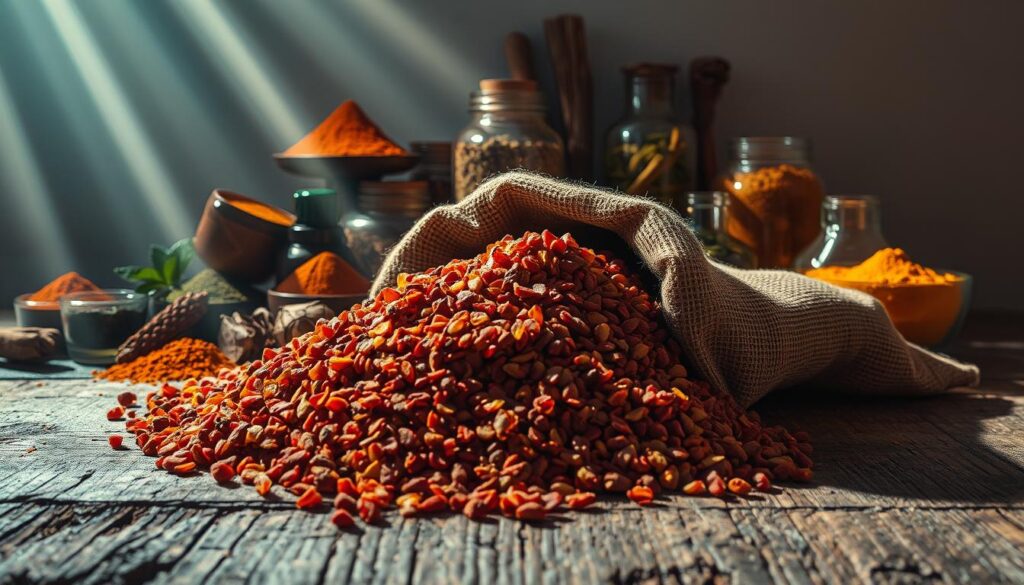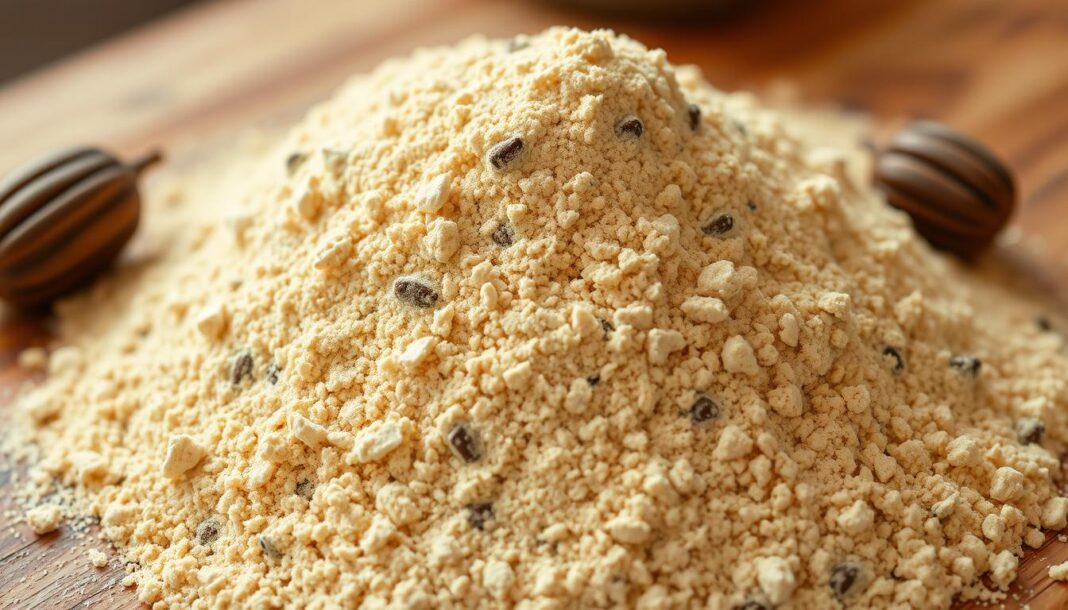We’re diving into the fascinating world of the spice melange, a mysterious substance that forms the backbone of Frank Herbert’s Dune universe. This complex spice blend is not only central to the series but also serves as a compelling metaphor for valuable resources.
In the Dune series, melange is the most essential and valuable commodity in the known universe, granting users a longer lifespan, greater vitality, and heightened awareness. As we explore this fictional spice blend, we’ll examine its role as both a literal substance and a powerful literary device representing scarcity, addiction, and power.
Key Takeaways
- Understanding the significance of melange in the Dune series
- Exploring the role of the spice melange in interstellar travel and politics
- Analyzing the literary device of melange as a representation of scarcity and power
- Examining the cultural impact of the Dune series on science fiction
- Gaining insight into Frank Herbert’s masterful worldbuilding
What Is the Spice Melange?
As we explore the Dune universe, we find that the spice melange is a naturally occurring substance with extraordinary properties. The spice melange first appeared in Frank Herbert’s groundbreaking 1965 novel Dune and continued to play a central role throughout the series, serving as the foundation for the complex political and economic systems Herbert created.

Origins in Frank Herbert’s Dune Universe
In the Dune universe, melange is found exclusively on the desert planet Arrakis, making this harsh world the most strategically important location in the entire galactic empire. The spice is not merely a flavoring but a powerful psychotropic substance with remarkable properties that affect human physiology and consciousness.
The Significance of Arrakis
By the time House Atreides arrived on Arrakis, melange had become the single resource that was capable of creating or destroying an empire. Consequently, Arrakis had gone from being a distant, poor, and unimportant desert world to a greatly prized fief. The significance of Arrakis (also known as Dune) cannot be overstated—this seemingly desolate planet holds the universe’s most precious resource, transforming it from an overlooked wasteland to the most contested territory in existence.
The Physical Properties of the Spice Melange
The Spice Melange, a substance central to Frank Herbert’s Dune universe, exhibits a range of fascinating physical properties. We will explore how these characteristics contribute to its mystique and significance within the narrative.
Appearance and Sensory Characteristics
The Spice Melange’s appearance is described variably across Herbert’s works. In its raw form, it appears as a reddish-brown substance with fluorescent blue undertones when exposed to certain lighting conditions, giving it an otherworldly appearance. The smell of melange is consistently described as having a strong cinnamon-like aroma, a characteristic that is unmistakable and impossible to replicate synthetically. When processed into gas, melange takes on an orange hue, as seen in the containers used by Guild Navigators.

Chemical Composition in the Dune Universe
While the exact chemical composition of melange is not fully explained in scientific terms, Herbert suggests it involves complex organic compounds that interact with human physiology in unprecedented ways. This complexity contributes to the substance‘s enigmatic nature and its critical role in the Dune universe, particularly in extending life and enhancing cognitive abilities. The unique content of melange makes it invaluable to various factions within the narrative.
How the Spice Melange Is Formed
On the desert planet of Arrakis, a unique ecological cycle gives rise to the valuable spice melange. This process is intricately linked to the lifecycle of the giant sandworms that roam the desert sands.
The Sandworm Lifecycle
The lifecycle begins with tiny organisms called sandtrout, which serve as the larval stage of the giant sandworms. These sandtrout play a crucial role in the planet’s water cycle by encapsulating any free-standing water. As they grow, they produce fungal excretions that mix with trapped water deep beneath the desert surface, creating a pre-spice mass.
The Pre-Spice Mass and Spice Blows
When pressure builds sufficiently, this pre-spice mass erupts to the surface in violent explosions called “spice blows,” which can be deadly to anyone in the vicinity. Once exposed to the air and intense sunlight of Arrakis, the pre-spice mass undergoes a transformation, becoming the valuable melange that is then harvested on the surface of the desert.
| Stage | Description | Outcome |
|---|---|---|
| Sandtrout Stage | Tiny organisms encapsulating water | Production of fungal excretions |
| Pre-Spice Mass Formation | Mixing of fungal excretions with water | Creation of pre-spice mass |
| Spice Blow | Erruption of pre-spice mass to the surface | Formation of melange |
The formation of melange involves a fascinating ecological cycle unique to the desert planet Arrakis, demonstrating Herbert’s remarkable attention to environmental worldbuilding. At the heart of spice production are the iconic sandworms of Arrakis, massive creatures that can grow hundreds of meters in length and dominate the desert ecosystem.
The Remarkable Effects of the Spice Melange
The spice melange, a cornerstone of Frank Herbert’s Dune universe, has multifaceted effects on those who consume it. The effects of the spice melange on the human body and mind are profound, blending elements of pharmacology, psychology, and metaphysics.
Geriatric Properties and Life Extension
One of the most significant benefits of consuming the spice melange is its ability to dramatically extend life expectancy. Regular consumption can triple the normal human lifespan while maintaining youthful vigor and health. This geriatric property makes the spice highly sought after across the Dune universe.
Mental and Cognitive Enhancement
Beyond mere life extension, the spice melange enhances mental abilities, sharpening awareness and increasing cognitive function. It awakens dormant parts of the human mind, allowing for expanded sensory perception. In certain individuals, heavy spice consumption unlocks the ability of prescience, enabling them to see potential futures.
The Blue Eyes of Ibad
A visible physical effect of sustained spice consumption is the transformation of the eyes into the “Eyes of Ibad,” where the whites and pupils turn a deep blue. This phenomenon serves as a visual identifier for those dependent on the spice. For those with extreme exposure, like Guild Navigators, the body undergoes radical transformations that enhance their prescient abilities.
| Effect | Description |
|---|---|
| Life Extension | Triples normal human lifespan |
| Cognitive Enhancement | Sharpens awareness and cognitive function |
| Prescience | Unlocks the ability to see potential futures |
| Physical Transformation | Turns eyes blue; radical body changes with extreme exposure |
For more detailed information on the spice melange, visit the Dune Wiki page on Spice Melange.
Harvesting the Spice Melange
On the harsh desert planet of Arrakis, the spice melange is harvested through a perilous mining operation. This process is not only complex but also fraught with danger due to the presence of massive sandworms that roam the desert sands.
Mining Operations
The industrial harvesting of the spice melange involves massive harvester vehicles designed to vacuum the spice from the desert surface. These operations are supported by sophisticated systems, including ornithopters for surveillance and carryall aircraft capable of lifting the mining vehicles to safety when sandworms are detected.
We observe that the rhythmic vibrations produced by the mining equipment attract the sandworms, creating a significant challenge that technology alone cannot overcome. The native Fremen people, however, have developed alternative methods that work in harmony with the desert ecosystem, allowing them to harvest the spice manually with less risk.
Dangers of Harvesting
The dangers associated with harvesting the spice melange are multifaceted. The sandworms, which can be up to 400 meters in length, pose a constant threat to the mining operations. The industrial approach to harvesting is thus a race against time, as the mining teams must extract as much spice as possible before the sandworms arrive.
The contrast between the industrial mining operations and the Fremen’s manual harvesting techniques highlights the ecological themes present in Herbert’s work. By understanding and respecting the behavior of the sandworms, the Fremen are able to collect the spice with significantly less risk, demonstrating that working with nature rather than against it can yield more sustainable results.
| Harvesting Method | Risks Involved | Ecological Impact |
|---|---|---|
| Industrial Mining | High risk due to sandworm attacks | Significant disturbance to the desert ecosystem |
| Fremen Manual Harvesting | Lower risk due to understanding of sandworm behavior | Minimal disturbance, works in harmony with the ecosystem |
Groups Critically Dependent on the Spice Melange
In the Dune universe, the spice melange is not just a valuable resource, but a necessity for certain key organizations. Several powerful factions have developed critical dependencies on the spice melange, each utilizing it in unique ways that fundamentally shape their structures and abilities.
The Spacing Guild and Navigators
The Spacing Guild holds a vital dependency on the spice melange, as their Guild Navigators consume massive quantities of spice gas to achieve the prescience necessary for guiding ships safely through folded space, making all interstellar travel possible. This dependency underscores the Guild’s reliance on the spice for their very function in the universe.
The Bene Gesserit Sisterhood
The Bene Gesserit Sisterhood incorporates the spice melange into their complex training and ritualistic practices to enhance their mental and physical abilities. For the Bene Gesserit, the spice plays a crucial role in their Reverend Mothers’ ability to access genetic memory through a dangerous ritual involving the Water of Life, a derivative of the spice.
The Fremen of Arrakis
The Fremen of Arrakis have the most intimate relationship with the spice melange, incorporating it into their daily diet and religious practices. This gives them enhanced strength, vitality, and the distinctive blue eyes that mark them as desert dwellers. The Fremen use spice not only for physical benefits but also in religious ceremonies to induce prophetic trances.
| Group | Dependency on Spice Melange | Use of Spice |
|---|---|---|
| Spacing Guild | High | Guild Navigators consume spice gas for prescience in interstellar travel |
| Bene Gesserit Sisterhood | Moderate | Use spice in training and rituals to enhance mental and physical abilities |
| Fremen of Arrakis | High | Incorporate spice into diet and religious practices for strength, vitality, and prophetic trances |
The Economic and Political Value of Melange
The melange, a rare and potent substance found only on Arrakis, has become the cornerstone of economic and political power in the Dune universe. Its value is so immense that it dictates the flow of wealth and influence across the known universe.
As a currency, the spice melange is unparalleled. It’s said that a briefcase full of melange could purchase an entire planet, making it the ultimate standard of value. This extreme value creates a significant wealth disparity, where the ability to consume spice regularly is a status symbol reserved for the truly powerful.
Currency and Wealth
The spice melange functions as a unique currency, with its value exceeding that of all other commodities combined. The Great Houses of the Imperium are considered rich and influential based on their ability to afford and stockpile melange. This has led to a situation where control of Arrakis, the sole source of melange, represents the most significant political leverage in the universe.
| Aspect | Economic Impact | Political Impact |
|---|---|---|
| Control of Arrakis | Dictates the global economy | Grants immense political power |
| Spice Production | Influences wealth distribution | Affects the balance of power |
| Melange Consumption | Symbol of wealth and status | Indicator of political influence |
Political Power and Control
During the reign of the God Emperor Leto Atreides II, the political dynamics of spice changed dramatically. He restricted production to maintain control over factions dependent on it, creating massive stockpiles that later proved valuable. This control over melange was a key factor in his maintained power over the empire for over 3,500 years.
The value of melange extends beyond wealth to represent power over life itself. Those with access to it can extend their lives for centuries, while those without it age normally. This has profound implications for the societies that rely on it, creating parallels to our world’s reliance on irreplaceable commodities like oil.
Real-World Parallels to the Spice Melange
The spice melange, a pivotal element in Frank Herbert’s Dune series, draws fascinating parallels to real-world substances and phenomena. We observe that Herbert’s creation combines elements of psychoactive compounds, precious resources, and biological phenomena, making it a rich subject for analysis. The economic and political dynamics surrounding the control of melange on the desert planet Arrakis mirror our world’s historical and ongoing conflicts over valuable resources. Certain nematode worms can enter a “dauer state” that dramatically extends their life expectancy, suggesting Herbert may have drawn inspiration from actual biological phenomena. The dependency of the Spacing Guild on spice for interstellar travel creates an interesting metaphor for humanity’s reliance on fossil fuels. Herbert’s fictional substance serves as a powerful literary device that continues to resonate with readers. The complexity of melange demonstrates Herbert’s remarkable ability to create a single fictional element that ties together the entire known universe.
By exploring these parallels, we gain a deeper understanding of the spice melange and its significance in the Dune universe, as well as its relevance to our own world’s challenges and complexities.


